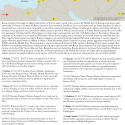 |
 |
Russian Military Activity: October 27-November 3, 2015

Russia continues to leverage its military intervention in Syria to assert its great power status in the Middle East. Following inconclusive multilateral talks in Vienna on October 30, Russia claimed to have conducted airstrikes in direct coordination with the Syrian opposition in order to present itself as a cooperative actor, and possibly to sow distrust among rebel groups. Russia strengthened its military partnership with Iran by closing in on an agreement over a previously-stalled contract to provide S-300 anti-aircraft systems to Tehran. Russia activated its air de-confliction agreements with Israel and the US, carrying out a short range communications test with a U.S. fighter plane on November 3. Russia also responded on November 3 to an attack by ISIS south of Homs city by sending attack helicopters to a forward airbase near the ISIS front line. Preserving the Syrian regime may require Russia to engage on the central Syrian front against ISIS while maintaining its current support to regime offensives against rebels and Jabhat al-Nusra in Syria. Meanwhile, Russia continued to project military aggression toward the U.S. and NATO outside the Middle East. Russia launched a snap naval aviation drill near its Baltic enclave of Kaliningrad after reports emerged that NATO was considering bolstering its military presence along its eastern border with Russia. Russia launched one of its largest missile tests of the year on the day of the Vienna talks over Syria. Russia also may have backed pro-Russian parties in the former Soviet republic of Moldova, which ousted the pro-EU government on October 29. Russia’s operations in the Middle East are part of a larger effort to expand Russia’s military presence and political influence at the expense of the U.S. and its allies to an extent not witnessed since the end of the Cold War.